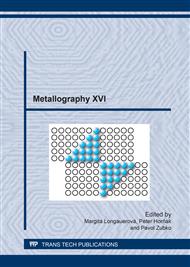p.565
p.569
p.574
p.579
p.589
p.596
p.602
p.608
p.613
An Ancient Bronze Ingot Smelted from Fahlore
Abstract:
A bronze bun ingot fragment, produced in an ancient furnace, was investigated. The original surface was craggy and covered by a dark green “layer” of corrosion products and at the intersection shrink holes are visible. X-ray fluorescence analysis confirms Cu as balance, up to 4 wt.% As respectively 2.5 wt.% S and smaller amounts of Sb, Ni, Fe, Ag were measured. This composition suggests that fahlores were processed. An inhomogeneous microstructure was observed over the cross section of the ingot caused by the alloying elements and their segregation during solidification of the melt. The microstructure is dominated by copper dendrites and the interdendritic regions are enriched with the residual alloying elements which form precipitates. Near the ingot surface large oxide crystals were observed indicating oxide formation during the solidification of the melt. Another kind of fine-grained oxides were identified which are formed potentially by corrosion. We can conclude that the ingot is arsenic bronze with quite a complex microstructure.
Info:
Periodical:
Pages:
613-617
Citation:
Online since:
March 2017
Authors:
Keywords:
Price:
Сopyright:
© 2017 Trans Tech Publications Ltd. All Rights Reserved
Share:
Citation:


